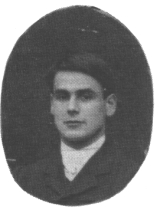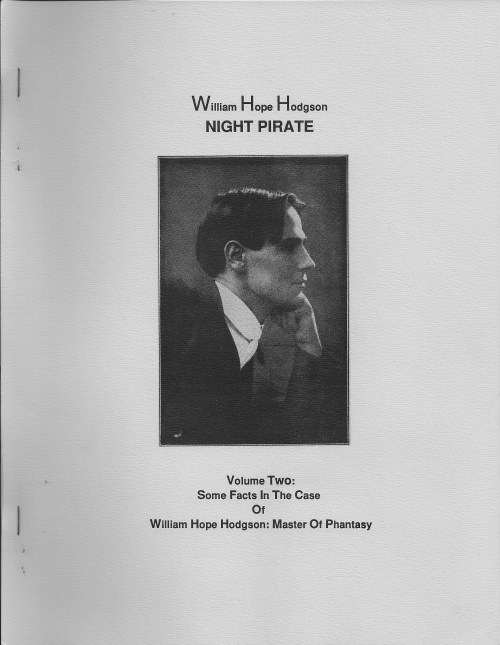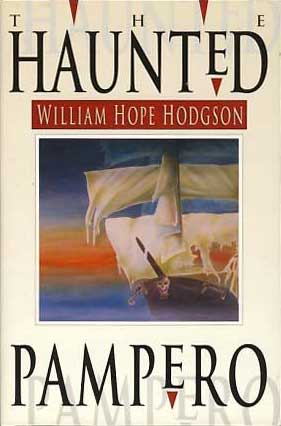Here is the 6th part of our reprinting of R. Alain Everts’ biographical article about William Hope Hodgson. In this section, Everts talks about WHH’s continuing attempts to become a successful author and his eventual disappointments.
We now commonly accept that the bulk of WHH’s best fiction was written early in his writing career. We see here that the reason he did not continue in this vein was because of the poor sales of his work. Who knows what works of imagination were lost because of an unappreciative public?
(I have not, as yet, been able to identify the source of the quote from Arthur Waugh. Anyone have any clues?)

A nice profile shot of WHH in uniform. Likely around 1916 or so.
SOME FACTS IN THE CASE OF WILLIAM HOPE HODGSON: MASTER OF PHANTASY
by R. Alain Everts
LITERARY CAREER, Part One
In late 1910, Hope decided that he would be able to make a better success of himself in the writing field if he were domiciled in London—and so he moved to London where he could be in the proximity of publishers, and where he could involve himself in the literary and cultural atmosphere of that great city. In December, 1911, Lissie and her mother left Glaneifion and moved into a house, on the north-eastern outskirts of Borth, renamed Lisswood in honor of LIssie, where the would remain until Mrs. Hodgson’s death.
Hope’s first book was published in October, 1907, after it had been rejected many times. Shortly after its appearance, Hope traveled to Town, and dropped in on his publisher at Chapman & Hall, Mr. Arthur Waugh, who recalled more than two decades later:
“That eccentric but highly imaginative young novelist, W. Hope Hodgson, author of an eerie story called The Boats of the “Glen Carrig”. It is good stuff, but it was not selling as it deserved, and Hope Hodgson plunged into the office all afire with a tremendous idea for publicity. A huge boat was to be constructed, with cutter sails and rigging, the mainsail to bear the name of the book, and the entire craft to be mounted on a lorry and driven along the Strand, Piccadilly, Oxford Street, and all thoroughfares where idle shoppers most do congregate. On the lorry were to be about a dozen men dressed as sailors, selling The Boats of the “Glen Carrig” to the crowd as they passed. When it was objected that the firm would most certain be indicted for obstructing traffic, Hope Hodgson banged out into the street again, swearing picturesquely. He never really forgave the firm its lack of enterprise, but the interval of his transit was lively and amusing.”
Such was the attitude, energy, enthusiasm and the confidence of W. Hope Hodgson—confidence that his work would sell well if sold properly. Hope was so disappointed with Chapman & Hall’s lack of initiative that although The House on the Borderland was published by them in the following year, the dissatisfied Hope went in search of another publisher. It was at Stanley Paul & Co., that he encountered a thoughtful and considerate publisher—Arthur St. John Adcock (1864-1930).
Hope had already been in touch with St. John Adcock, editor of the literary review The Bookman in which many of the favorable reviews of Hope’s writings first appeared. Hope first met him shortly after April 1909, when the following letter appeared at the office of The Bookman, published by Stanley Paul & Co.:
Dear Sir
I don’t know whether you remember a certain “muscular” individual who figured lately in your portrait gallery? Anyway he’s at the other end of these keys, and would be immensely obliged, if you would let him run up to have five minutes talk with you.
Five minutes: not a second longer.
You needn’t be afraid that I’ll either bore or keep you. I’d be more likely to kill, than do either.
Believe me dear Sir, Yours very
Faithfully,
William Hope Hodgson
This letter began a long friendship between the two men, and some years after Hope’s untimely death, in 1920, St. John Adcock recalled this first meeting:
I first met Hope Hodgson about eleven years ago. At that date his three best novels had been written; two of them The Boats of the “Glen Carrig” and The House on the Borderland had been published, and the third, The Ghost Pirates, was in the press. In those three stories he showed himself a writer of quite exceptional imaginative gifts, a master of the weird, the eerie, the terrible, whose strange and grim imaginings were not unworthy of comparison with the bizarre creations of Poe. He had already given himself so entirely and enthusiastically to a literary career that the talk of our first meeting was wholly of books and of his hopes as an author. He aimed high, and was taking his art very seriously, had a frank, unaffected confidence in his powers, which was party the splendid arrogance of youth and partly the heritage of experience, for he had tested and proved them.
There was something curiously attractive in his breezy, forceful, eager personality; his dark eyes were wonderfully alert and alive; he was wonderfully and restlessly alive and alert in all his mind and body. He was emphatic and unrestrained in his talk, but would take the sting out of an extravagant denunciation of some inartistic popular author, or of some pestilent critic, and the egotism out of some headlong confession of his own belief in himself with the pleasant boyish laugh that brushed it all aside as the mere spray and froth of a passing thought. His dark, handsome features were extraordinarily expressive; they betrayed his emotions as readily as his lips gave away whatever happened to rise in his mind. Always he had the courage of his opinions and no false modesty; it never seemed to occur to him to practice political subterfuges; and it was this absolute candor and naturalness that compelled you to like him and before long strengthened your liking into a friendly affection.
Apparently they talked of other matters, for Hodgson was given job reviews—book to review for The Bookman. On 19, October 1909, he writes to St. John Adcocke that he is enclosing the review to Kipling’s “Actions and Reactions”, with a review of “How to Study the Stars” to follow in time for the 30 October. Hope also requested to have “The Unseen Thing” by Anthony Dallington—obviously a horror book—so that he can review it. Without doubt this reviewing continued successfully for some time, and without a doubt the literary lure of London, plus the dispersing of the Hodgson family, convinced Hope that he could do well on his own in London. Hope continued to sell his mss from Borth, but about mid-1911, he moved to London, mixing in the numerous literary get-togethers and events, meeting such authors as Frank Swinnerton and George Bernard Shaw, and of course pushing his short stories with numerous magazine offices. Hope had his Carnacki, The Ghost Finder and a poem appear in London and New York in 1910—comprising apparently of the one tale and one poem—(editor’s [Everts] note, abridged version of four of the tales and the poem “Lost”)—it was later to be reprinted as a collection of six stories (Eveleigh Nash, 1913). He had also arranged to have Eveleigh Nash accept his prodigious The Night Land, which finally came out in August, 1912. By now, Hope’s fortunes, financially and literary, were picking up, and he contemplated marriage—not to the young debutantes that he knew—but to an old home-town girl, Bessie Gertrude Farnworth.
This period also was to end Hope’s serious writings in the genre of the horror and phantasy tale (1910-1912)—The Night Land, the third part of what Hope referred to as his first trilogy (The House on the Borderland; The Ghost Pirates; The Night Land), and the part he considered to be his magnum opus. He was terribly disappointed when it did not sell well, and so for the remainder of his life he turned to short stories only—never to return to the novel format. And, notably he rarely returned to phantasy or horror after the failure of The Night Land, employing a new type of story as he described it, allowing him to present new ideas—could this be a reference to his almost, from then on, simple sea stories?? If so, how sad—but unfortunately, these pot-boilers brought him a steady income. His disappointment extended not only to the reading public for failure to admire and appreciate the masterpiece he had written, but also to his own family. None of the Hodgsons were able to understand any of Hope’s writings completely—the girls were scared to death by most of his horror tales—while the Farnworth family was just as bad.
From then on, Hope stuck for the most part to light sea stories—which guaranteed an income instantly as opposed to the profits on slow selling novels (he claimed in 1915 that neither Carnacki or The Night Land brought him “one farthing”)—trite for the most part, and boring little bits of fluff. His subsequent books were the reprint Carnacki, The Ghost Finder (Eveleigh Nash, 1913) and a cheaper reprint the following year: Men of the Deep Waters, also from Eveleigh Nash, coming out in September, 1914, and made up primarily of sea stories (with some horror) written mostly prior to 1910; The Luck of the Strong, a collection similar to Men, put out by Nash in 1916; and a final collection of stories—Captain Gault (Eveleigh Nash, 1917)—all tales therein having been written during Hope’s sojourns to France. A posthumous collection of poems came out in March 1920—The Calling of the Sea—many early poems were included—and this proved of such interest that a second volume was put out in November 1921—The Voice of the Ocean—both from Selwyn & Blount of London.
















![unutterable-horror-a-history-of-supernatural-fiction-vol-2-s_t_-joshi-1593-p[ekm]257x300[ekm]](https://williamhopehodgson.files.wordpress.com/2013/01/unutterable-horror-a-history-of-supernatural-fiction-vol-2-s_t_-joshi-1593-pekm257x300ekm.jpg?w=500)